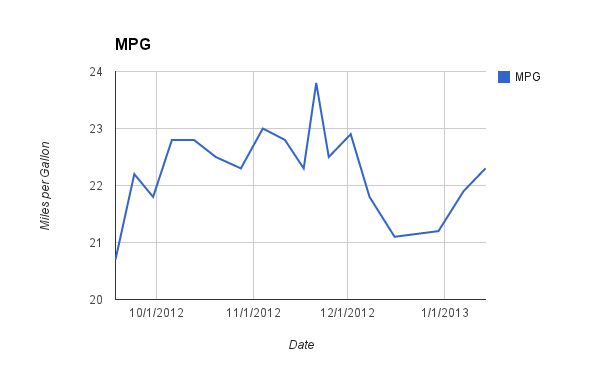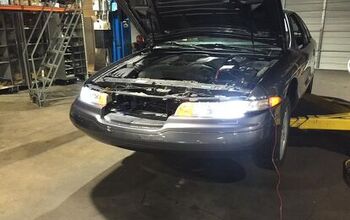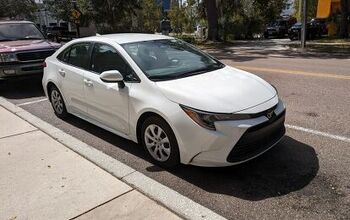Piston Slap: Charting the Changes, To What End?

TTAC commentator wannabewannabe writes:
Hey Sajeev,
I wrote you a while back about my 1990 Chevy pickup, but I’ve since moved on to more interesting cars.
I have a 1994 Cadillac Fleetwood Brougham (B/D-Body with an LT1 FTW!) that looks literally identical to this one, same color inside and out. It currently has just under 184k miles on it, is my daily driver, and is in pretty good shape. Very reliable car!
My question concerns fuel economy, and it’s stumped me. I commute between 75-80 miles round trip every day, which makes my weekly mileage about 400 miles, so I fill up once a week. I always fill up at the same gas station, I drive the same routes on the same days, no one else drives my car, and because my commute is mostly freeway, I’m a copious user of cruise control. Also, I should mention that because I live in the Bay Area in California, our weather doesn’t vary wildly; it’s usually relatively mild. Yet given all this, my gas mileage routine varies up to 15%. Some weeks I average about 21mpg, while other weeks I average about 24mpg. To be fair, the average is in the 22.5mpg range, and you’ll see a good number of data points there too.
I would expect some variation based on the automatic shut off on the pumps and to a certain degree, variances in temperature, particularly when filling up, but I’m surprised that my fuel economy swings as much as it does. I’ve included a rudimentary chart to show you the swings, though it doesn’t have the last month of data included. Thoughts?
Sajeev answers:
Nice rig! You’ve certainly done a great job explaining your situation..and is it ever a doosie!
The most logical choice, given your input, is the gas pumps do shut off at different “full” levels. Perhaps there’s something wrong with your Caddy’s vapor recovery system that’s making it happen. Usually that throws a trouble code and a light on the dash, so probably not applicable here.
Perhaps the weather may feel about the same, but the problem is exacerbated by a change in barometric pressure? Is that even possible?
If, by any chance, you haven’t changed your Oxygen (o2) Sensors, do it! The engine computer is only as efficient as the information it receives. And flaky sensors could cause the variance we see here, especially if they are original at this mileage. Worn out, but not enough to throw a trouble code. It’s possible!
The O2 sensors sound more likely, the more I ponder this. Off to you, Best and Brightest!
Send your queries to sajeev@thetruthaboutcars.com. Spare no details and ask for a speedy resolution if you’re in a hurry…but be realistic, and use your make/model specific forums instead of TTAC for more timely advice.

More by Sajeev Mehta
Latest Car Reviews
Read moreLatest Product Reviews
Read moreRecent Comments
- 3SpeedAutomatic 2012 Ford Escape V6 FWD at 147k miles:Just went thru a heavy maintenance cycle: full brake job with rotors and drums, replace top & bottom radiator hoses, radiator flush, transmission flush, replace valve cover gaskets (still leaks oil, but not as bad as before), & fan belt. Also, #4 fuel injector locked up. About $4.5k spread over 19 months. Sole means of transportation, so don't mind spending the money for reliability. Was going to replace prior to the above maintenance cycle, but COVID screwed up the market ( $4k markup over sticker including $400 for nitrogen in the tires), so bit the bullet. Now serious about replacing, but waiting for used and/or new car prices to fall a bit more. Have my eye on a particular SUV. Last I checked, had a $2.5k discount with great interest rate (better than my CU) for financing. Will keep on driving Escape as long as A/C works. 🚗🚗🚗
- Rna65689660 For such a flat surface, why not get smoke tint, Rtint or Rvynil. Starts at $8. I used to use a company called Lamin-x, but I think they are gone. Has held up great.
- Cprescott A cheaper golf cart will not make me more inclined to screw up my life. I can go 500 plus miles on a tank of gas with my 2016 ICE car that is paid off. I get two weeks out of a tank that takes from start to finish less than 10 minutes to refill. At no point with golf cart technology as we know it can they match what my ICE vehicle can do. Hell no. Absolutely never.
- Cprescott People do silly things to their cars.
- Jeff This is a step in the right direction with the Murano gaining a 9 speed automatic. Nissan could go a little further and offer a compact pickup and offer hybrids. VoGhost--Nissan has laid out a new plan to electrify 16 of the 30 vehicles it produces by 2026, with the rest using internal combustion instead. For those of us in North America, the company says it plans to release seven new vehicles in the US and Canada, although it’s not clear how many of those will be some type of EV.Nissan says the US is getting “e-POWER and plug-in hybrid models” — each of those uses a mix of electricity and fuel for power. At the moment, the only all-electric EVs Nissan is producing are the Ariya SUV and the perhaps endangered (or maybe not) Leaf.In 2021, Nissan said it would make 23 electrified vehicles by 2030, and that 15 of those would be fully electric, rather than some form of hybrid vehicle. It’s hard to say if any of this is a step forward from that plan, because yes, 16 is bigger than 15, but Nissan doesn’t explicitly say how many of those 16 are all-battery, or indeed if any of them are. https://www.theverge.com/2024/3/25/24111963/nissan-ev-plan-2026-solid-state-batteries


































Comments
Join the conversation
Easy way around the pump shut-off issue is to track it by gallons per fill, and mileage between fills. A "fill" is however much you put in; doesn't have to be a top-off.
I also live in the Bay Area and I also keep a log book of mileage (and other car-related odds-and-ends). I think your problem is the automatic shutoff system of gas pumps. I've noticed that if I lock the gas pump nozzle to maximum fill speed it usually stops short. Usually it's between 0.5 and 2 gallons short but sometimes it'll just stop anywhere. That could entirely explain your inconsistent results. While fueling I try to estimate how many gallons I'll need based on miles traveled, expected fuel efficiency, gas gauge reading, and the car's own estimation of miles remaining until empty. Then, when I'm 2 gallons shy of full I reduce the nozzle fill speed to the slowest speed and also hold the nozzle more upright. That seems to result in consistent fills.